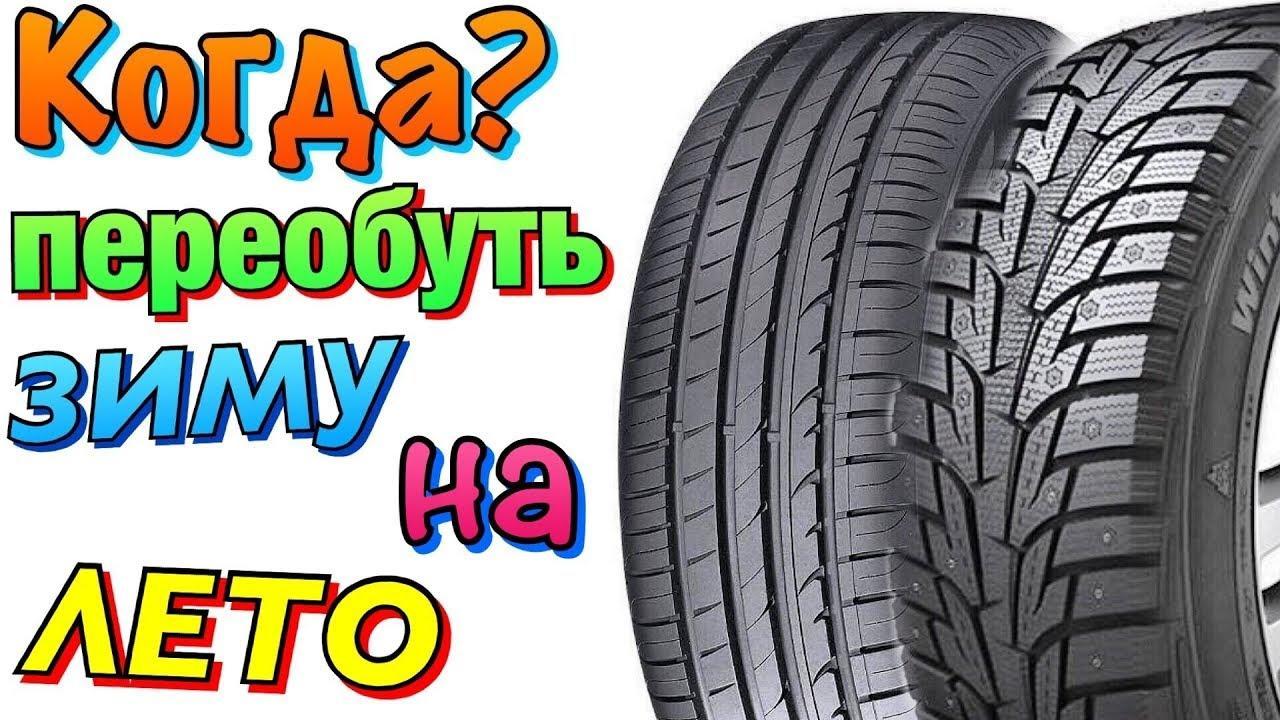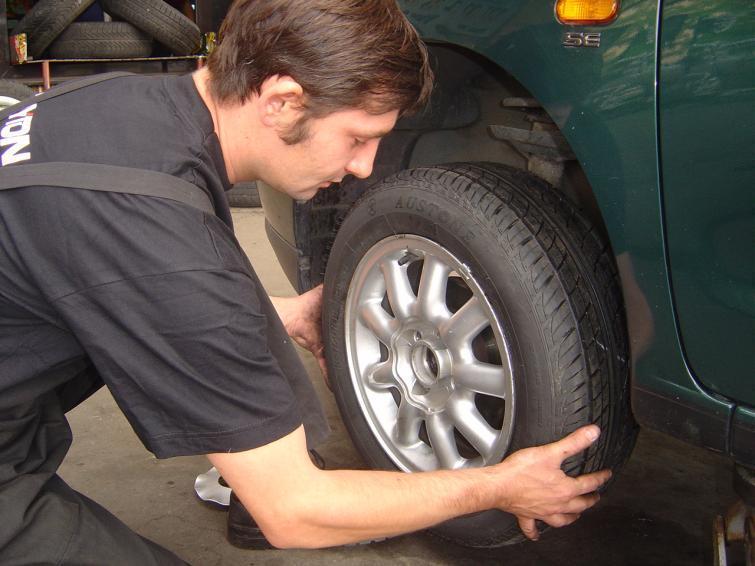
Summer tires - when to change, what to remember, what to do with winter tires (VIDEO)
Content
 It is better not to rush to replace winter tires with summer ones, but this year spring came quickly. Therefore, in the coming weeks, vulcanizing plants will be swarming with customers. We advise what you need to remember when changing tires to summer.
It is better not to rush to replace winter tires with summer ones, but this year spring came quickly. Therefore, in the coming weeks, vulcanizing plants will be swarming with customers. We advise what you need to remember when changing tires to summer.

Tire manufacturers claim that summer tires are best suited for installation on wheels when the average daily temperature exceeds seven degrees Celsius for several days in a row. Spring is almost everywhere in Poland, but weather forecasters say that you should not rush to change tires. After all, winter has not yet said the last word:
Source: TVN Turbo / x-news
Summer and winter tires have different tread patterns. The former have larger grooves, but they are located less frequently. On the one hand, this is to facilitate the removal of water from under the wheels in the rain, and on the other hand, to improve traction on dry surfaces. Meanwhile, a winter tire has more small cuts, so-called sipes, that improve traction on snow and ice.
Apart from the different tread pattern, the main difference between summer and winter tires is their composition. The winter tire, rich in soft silicone and silicone, is more pliable at low temperatures, making the car turn better and brake better on snow. In summer, such a tire wears out quickly and the car clings to the road worse than on summer tires. This makes it easier to skid in a turn or during emergency braking.
Check tires for damage before replacing.
Tire replacement this year will be no more expensive than last season. On most sites, for a spacer for a set of tires on steel rims, you need to pay PLN 50-60, and for alloy wheels - PLN 60-70. The cost of the service includes dismantling winter tires, replacing valves, installing summer tires, as well as balancing the wheels and screwing them onto the hubs.
“When the customer has the second set of wheels ready, all that remains is to balance, check the air pressure and install it on the car,” says Andrzej Wilczynski, an experienced vulcanizer from Rzeszów.
For this service you pay PLN 10 per wheel.
Before visiting the vulcanizer, it is worth checking the condition of summer tires. It may turn out that they are already worn out and instead of replacing you will need to buy a new set.
See also: Installing HBO on a car. What you need to remember to make money on gas?
- The tire will be disqualified due to any bulges, bumps and rubber defects. The tread should be at least four millimeters high, preferably evenly worn across the entire width of the wheel. If a tire is bald on one side and heavily treaded on the other, the car will not ride well or brake safely,” Wilczynski lists.
Uneven tire wear is also indicative of problems with the vehicle's suspension geometry.
Tire age also matters. It is assumed that rubber loses its properties after four years, and then it is best to buy new tires. In practice, if the tires are good, you can easily ride them for five or six seasons. The state of the mixture is influenced, among other things, by the corresponding cosmetics. A tire regularly lubricated with special preservatives will retain its flexibility longer than a tire that no one cleans from chemicals, gasoline, oils and greases.
See also: Ignition system malfunctions. How to avoid them?
Summer tires - follow the instructions when choosing a size
If the tires can only be thrown away, you should consider buying a new set. In the case of summer tyres, retreaded tyres, also known as solid tyres, are not recommended in the first place. Their production consists in pouring a new tread onto the structure of an old tire. Previously, only the upper part of the tire was covered with fresh coating. Today, it is also applied to the sides, which makes the tires more durable. However, they are still more susceptible to damage and delamination at high temperatures.
- Therefore, it is better to buy new tires. For city driving, domestic tires are enough, which are the cheapest, but are not much inferior in quality to premium brands. The main difference lies in the type of tread, which is more difficult in more expensive tires. Cheaper brands are a little behind in this regard, but often they are premium models, but released a few years ago, says Arkadiusz Yazva, owner of a vulcanization plant in Rzeszow.
More expensive tires are recommended primarily for drivers of larger vehicles with sporty characteristics. High wear resistance and modern tread are ideal for fast driving and long trips.
The vulcanizers claim that the choice of tire size is more important than the tire manufacturer. It is best to buy them in the sizes recommended by the manufacturer (they are stamped on the nameplate and are given in the instructions). A tire that is too small or too large is a risk of strut misalignment and faster wear of the suspension components. In addition, an excess of rubber can damage the body, and a lack of rubber will affect driving comfort. “Fortunately, there is always an alternative. Instead of the very popular 195/65/15, we can assume 205/55/16 or 225/45/17,” says Yazva.
The diameter of the wheel with tire and rim replacement must not differ too much from the diameter specified by the vehicle manufacturer. It is supposed to be within +1,5%/-2%. exemplary.
See also: Maintenance and battery charging. Maintenance free also requires some maintenance
– Tires with a higher profile will work well in the city, where you often have to climb curbs or overcome sagging sewers. The low and wide profile, in turn, are better suited for long-distance trips on flat roads, explains Andrzej Wilczynski.
When choosing tires, you should also pay attention to the speed and load characteristics - they cannot be lower than those indicated by the car manufacturer.
For a year and a half, all tires sold in the European Union had additional labels. They provide information on wet grip, rolling resistance and noise levels. More about the new labels:
Click on the photo to go to the article about the new labels
Summer tires have not become more expensive - prices for popular models
Tire prices are the same as last year. For the popular Ford Fiesta Mk5 on our roads, the factory size is 175/65/14. The Dębica Passio 2 costs PLN 130, the Dayton D110 is PLN 132 and the Barum Brillantis 2 is PLN 134. Mid-range tires such as Fulda Ecocontrol already cost PLN 168 a piece, while UniRoyal RainExpert costs PLN 165. Premium tires such as the Goodyear Efficientgrip Compact or the PirelliP1 Cinturato Verde already cost PLN 190-210.
See also: Checking a car before buying. What is it, how much does it cost?
Another popular size is 195/65/15, used, for example, in the Opel Vectra C. Here, prices start from about PLN 160 for tires from Debica or Olsztyn, up to PLN 185 for Fulda and Kleber tires, about PLN 210–220 for GoodYear, Pirelli and Dunlop.
Another popular size is 205/55/16, used in most modern compact and medium models. At the same time, PLN 220 is enough for domestic or Daytona tires, PLN 240 for Sawa, Kleber or Fulda, and at least PLN 280-290 for Pirelli, Bridgestone and Continental.
Clean, preserve and store winter tires
What to do with the winter tires removed from the car? If tires are stored without rims, they should be placed on the tread, one next to the other. They should be turned over every three to four weeks to change where the tire contacts the ground. Cardboard or a wooden board can be inserted between the tires and the floor to isolate them from the floor. This is especially important when the substrate shows traces of oil, solvents, or other chemicals that are bad for the rubber. And the garage is not difficult.
See also: Inflate tires with nitrogen. Does it always pay off?
We store whole wheels a little differently. Lay them on top of each other. Wheels with rims should not be placed vertically because the weight of the rim will deform the rubber. In this case, it is also good to put cardboard or wood under the tire in contact with the floor. Once a month, the circle from the bottom moves to the top of the stack. The wheels can also be hung on a special hanger or stand, which can be purchased at hypermarkets or automotive stores. The cost of such a pen is about 70-80 zł.
– The tire storage place should be dry and cool, away from petrol, oil, paints, solvents and acids. It is also good that direct sunlight does not fall on the wheels. Before this, the tires should be washed and greased with milk or foam that has a preservative effect. I also recommend washing the discs thoroughly, which will prevent them from quickly corroding. Such well-maintained wheels will serve us for a long time,” adds vulcanizer Andrzej Wilczynski.
See also: Dandelion tires and other new tire technologies
An alternative to a basement or garage are tire warehouses, which operate mainly in vulcanizing plants. Storing a set of tires or rims throughout the season, depending on the city, costs about PLN 80-120.
Governorate Bartosz